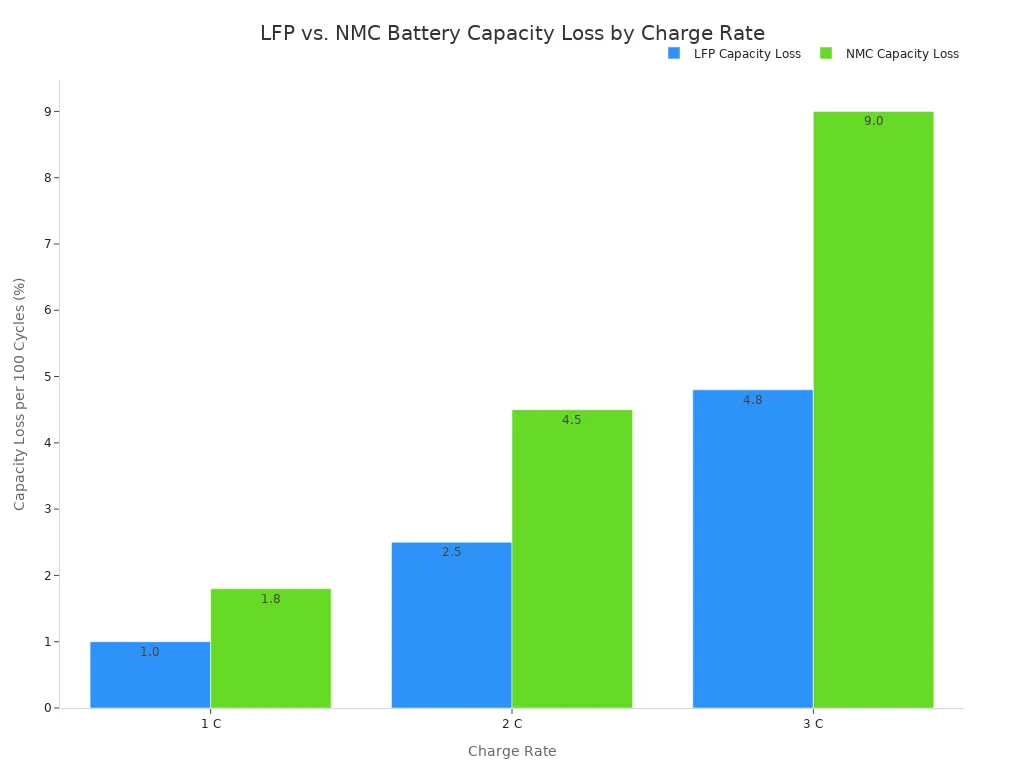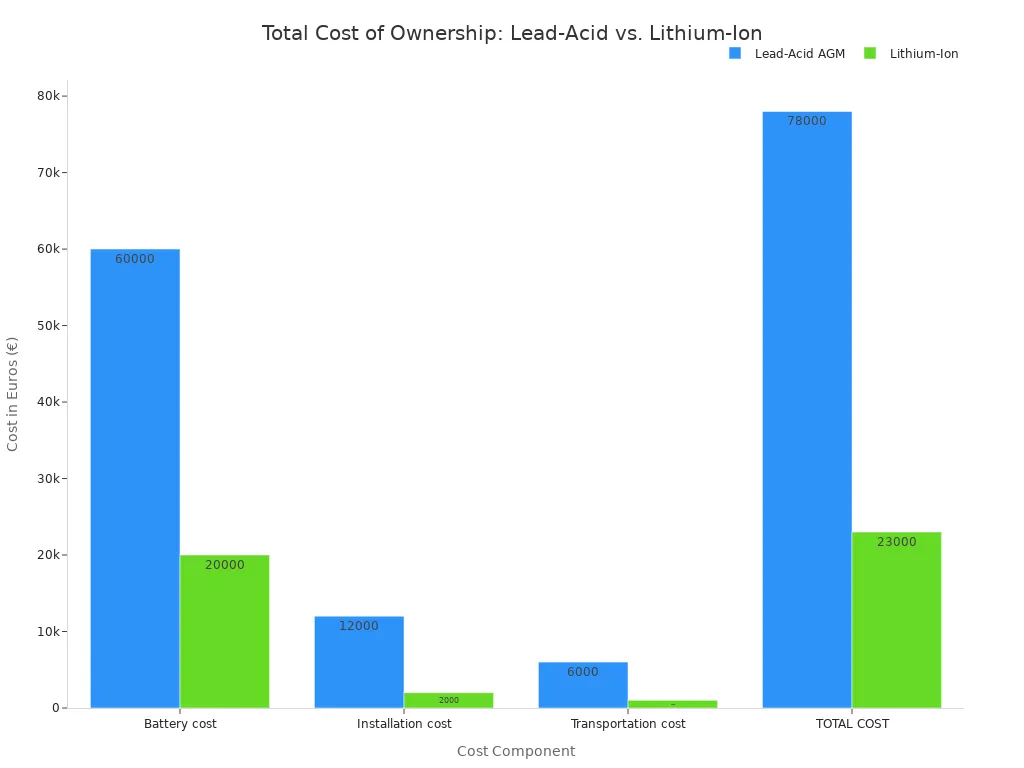
Choosing the best battery for your electric scooter is crucial in 2025. The clear winner is lithium-ion batteries. The market for electric scooters is growing quickly, with a projected 12.6% annual growth rate, because this lithium technology offers a superior electric experience. This lithium battery gives your scooter more range, a longer lifespan, and less weight.
Your choice of lithium battery will likely be between two main types. You can pick Nickel Manganese Cobalt (NMC) for top performance or Lithium Iron Phosphate (LFP) for maximum safety and longevity for your scooter.
Why Lithium-ion is the Best Battery
A modern electric scooter battery is more than just a single unit. It is a sophisticated pack containing many individual lithium cells. A crucial component called the Battery Management System (BMS) protects the battery from damage. You will find that reputable scooter brands often build their packs using high-quality cells from trusted manufacturers like LG, Samsung, and Panasonic. This focus on quality is why lithium-ion batteries deliver superior performance.
Higher Energy Density for More Range
Energy density measures how much power a battery can store for its size. Lithium batteries have a very high energy density. This high density means your electric scooter can travel farther on a single charge. A battery with greater energy density provides more range without adding extra weight.
Lithium-ion batteries possess excellent energy density. They store a significant amount of energy relative to their physical weight. This characteristic directly contributes to extended travel range for electric scooters.
The type of lithium chemistry affects the specific energy density. You can see how different battery types compare below.
| Тип батареи | Energy Density Characteristics |
|---|---|
| Lithium-ion (NMC/NCA) | High energy density, common in electric scooters for best performance. |
| Lithium-ion (LFP) | Good energy density with excellent safety and lifespan. |
| Lead-Acid | Lower energy density, resulting in a heavier battery and less range. |
Longer Lifespan and Charge Cycles
Your battery’s lifespan is measured in charge cycles. One cycle is a full charge from empty to 100%. Lithium-ion batteries offer a long battery lifespan. A standard lithium battery can typically handle От 300 до 500 циклов зарядки before its capacity drops noticeably. High-grade lithium batteries can last even longer, reaching 800 to 1,000 cycles. After reaching its maximum cycle life, the battery will still hold about 80% of its original capacity. This durability makes your investment last for years.
Lighter Weight for Better Portability
The weight of the battery greatly affects your scooter’s handling and portability. Lithium technology creates a lightweight battery. This reduced weight makes the electric scooter easier to carry. A lighter scooter is also more nimble and responsive during your ride. The high power-to-weight ratio of a lithium battery improves the overall efficiency and feel of your scooter. This makes your electric ride more enjoyable.
Faster Charging Times
You want to spend more time riding and less time waiting. Lithium-ion batteries help you do just that. They have much faster charging times compared to older battery technologies. A typical electric scooter battery takes between 3 and 8 hours to fully charge. The exact time depends on the battery capacity and the charger you use. This quick turnaround ensures your scooter is ready to go when you are.
Understanding Your Electric Scooter Battery
You know that lithium batteries are the best, but not all lithium types of batteries are the same. The chemistry inside the battery pack determines your scooter’s performance, safety, and lifespan. Let’s explore the three main types of batteries you will encounter: NMC, LFP, and NCA. Understanding these will help you choose the perfect electric scooter battery for your needs.
NMC (никель-марганец-кобальт)
If you want maximum performance from your electric scooter, you will likely find an NMC battery inside. These types of batteries are popular in high-performance scooters for a reason. NMC batteries have superior energy and power densities. This means they pack more power into a smaller, lighter package, giving you more range and faster acceleration. They are also highly efficient, often exceeding 90% performance during charging and discharging.
Key benefits of an NMC lithium battery include:
- Высокая плотность энергии: An NMC battery stores more energy for its weight. This gives your scooter extended range for longer rides.
- Lightweight Design: The lighter weight improves your scooter’s handling and acceleration. It makes the scooter feel more nimble.
- Stable Power Delivery: These cells provide consistent power. You will not experience sudden voltage drops when you accelerate or cruise.
- Enhanced Safety: Modern NMC packs include a smart Battery Management System (BMS). The BMS monitors temperature and charge levels to prevent overheating and ensure safety.
LFP (Lithium Iron Phosphate)
When your top priorities are safety and a long battery life, you should look for a scooter with an LFP battery. LFP is also known as LiFePO4. The chemical structure of a LiFePO4 battery is extremely stable. This stability makes LiFePO4 batteries much less likely to overheat or catch fire, offering you superior safety.
LiFePO4 batteries also have an incredible cycle life. While a standard lithium battery lasts for 500-1,000 cycles, a LiFePO4 battery can endure От 2 000 до 5 000 циклов зарядки. This means a LiFePO4 battery can last over 10 years with proper care, making it a fantastic long-term investment.
| Характеристика | Аккумулятор LFP (LiFePO4) | NMC Battery |
|---|---|---|
| Безопасность | Excellent (Lower risk of thermal runaway) | Good (Requires complex thermal management) |
| Цикл жизни | 2,000–5,000+ cycles | 500–1,000 cycles |
| Плотность энергии | Нижний | Выше |
| Cold Weather | Reduced performance | Better performance |
| Стоимость | Lower upfront cost | Higher upfront cost |
LFP leads on safety, cycle life, cost, and carbon, while NMC excels when every kilogram and minute count.
The trade-off for the enhanced safety and longevity of LiFePO4 is a lower energy density compared to NMC. This means a LiFePO4 battery of the same capacity will be heavier. Fast charging also affects these types of batteries differently. NMC batteries lose capacity almost twice as fast as LiFePO4 batteries when charged at high rates. This chart shows how much capacity is lost per 100 fast-charge cycles.

For daily commuters who value reliability and ultimate safety, LiFePO4 is an unbeatable choice.
NCA (Nickel Cobalt Aluminum)
You might also hear about NCA lithium batteries. These types of batteries offer a very high energy density, similar to or even greater than NMC batteries. You can see their energy density characteristics below.
| Тип батареи | Energy Density (Wh/Kg) |
|---|---|
| NCA | 250-300 |
| NMC | 200-260 |
| LFP (LiFePO4) | 100-160 |
Despite their impressive capacity, NCA batteries are less common in the electric scooter market. They have a shorter lifespan and higher cost compared to NMC and LFP. Their safety profile is also a concern, as they require very precise management to operate safely. For these reasons, you will typically find NCA technology in high-end electric vehicles but rarely in a personal electric scooter.
Lithium-ion vs. Lead-Acid Batteries

You might see older or budget scooters using lead-acid batteries. However, a direct battery comparison shows why modern lithium technology is the superior choice. Let’s break down this battery comparison.
Range and Weight
The difference in range and weight between a lithium battery and a lead-acid battery is significant. A lithium battery is much lighter. It can be up to five times lighter than a lead-acid battery with similar capacity. This reduced weight makes your scooter easier to carry and handle.
You also get more usable energy from a lithium battery. This means you can travel a longer range on a single charge. This battery comparison table shows how a lithium battery provides more power for its size.
| Performance Aspect | Lithium (LiFePO4) Batteries | Lead-Acid Batteries |
|---|---|---|
| Usable Capacity | 80-100% | 30-80% |
| Weight (relative) | О сайте one-third the weight | Тяжелее |
| Плотность энергии | Выше | Нижний |
Lifespan and Long-Term Cost
You may notice that lithium-ion batteries have a higher upfront cost. However, they offer a much better value over their lifespan. A lithium battery can last for thousands of charge cycles. A lead-acid battery typically lasts for only a few hundred cycles. This means you will replace a lead-acid battery multiple times before a single lithium battery wears out.
The total cost of ownership for a lithium solution is about 2.8 times cheaper than for a lead-acid solution. This is because of its longer lifespan and lower maintenance needs.
This chart clearly shows how the long-term costs add up. The initial investment in lithium pays off significantly over time.

Performance and Maintenance
Your electric scooter’s performance depends on consistent power. A lithium battery delivers steady power until it is nearly empty. A lead-acid battery’s voltage drops as it drains, reducing your scooter’s speed and acceleration.
Maintenance is another key area in this battery comparison. Lithium batteries are virtually maintenance-free. Lead-acid batteries require constant attention. You can avoid these chores with a lithium battery:
- Regularly checking and refilling water levels.
- Cleaning oxide buildup from terminals.
- Performing monthly specific gravity checks.
- Needing a special ventilated area for charging.
Choosing the Right Battery for Your Electric Scooter
Selecting the right battery ensures your electric scooter meets your needs. You must consider voltage, cost, and performance. Making an informed choice helps you get the most out of your electric ride. Finding the right battery is the most important step.
Matching Voltage: 36V vs. 48V
Voltage is a key factor for your scooter’s power. It acts like pressure, pushing electric current to the motor. Higher voltage means more power. Standard commuter electric scooters often use a 36V battery. High-performance models need a 48V battery for more speed and torque. You must match the battery voltage to your scooter’s motor and controller for proper compatibility. Using the wrong voltage can damage your scooter or severely limit its performance.
| Характеристика | 36V Battery | 48V Battery |
|---|---|---|
| Power Output | Умеренный | Высокий |
| Speed Potential | 15–20 mph | 20–28+ mph |
| Torque | Limited | Strong uphill performance |
Choosing the right battery voltage directly impacts your scooter’s capabilities and your riding experience.
Balancing Cost and Performance
Lithium-ion batteries have a higher initial cost than lead-acid options. However, you get a much better value over the battery’s life. A lithium battery offers a longer lifespan, better range, and superior performance. Customers who switch to a lithium battery can save an average of $700 over three years. The long-term savings come from the battery’s durability and low maintenance. You invest more upfront but save money because you do not need frequent replacements. This makes a lithium battery the smart financial choice.
Upgrading from Lead-Acid to Lithium
You can upgrade your older scooter from a lead-acid to a lithium battery. This upgrade will dramatically improve your electric scooter. You need to check a few things to find the right battery.
- Match the Voltage: Your new lithium battery must have the same voltage as your old system.
- Check the Amperage: The new battery must supply enough current (amps) for your scooter’s controller.
- Confirm the Capacity: A lithium battery provides more usable battery capacity. A 20Ah lithium battery offers more power than a 20Ah lead-acid battery.
- Ensure Physical Fit: A lithium battery is smaller and lighter. You must check if the new battery fits in the available space.
Important Tip: It is crucial to buy a quality battery from a trusted local seller. Avoid online marketplaces like Amazon or eBay. A reputable dealer ensures you get a safe, high-performance battery with a good capacity and a long life.
How to Maximize Battery Life

You invested in a great scooter with a lithium battery. Now you can protect that investment. Following a few simple rules will extend your battery life and ensure peak performance for years. Proper care is key to getting the most out of your electric ride.
Follow the 20-80% Charging Rule
You can significantly extend your battery’s cycle life by changing how you charge it. Try to keep the charge level between 20% and 80%. Charging to 100% or letting the battery drain completely puts mechanical and chemical stress on its internal parts. This practice keeps your battery in a “comfort zone.” It reduces wear and helps you get more charges over its life.
Avoid Extreme Temperatures
Your battery works best within a specific temperature range. Extreme heat or cold can reduce performance and cause permanent damage. For the best results and safety, you should follow these temperature guidelines.
- Optimal Charging Temperature: 32°F to 95°F (0°C to 35°C)
- Optimal Riding Temperature: 14°F to 113°F (-10°C to 45°C)
Pro Tip 💡: If your scooter has been out in the cold, bring it inside and let it warm up to room temperature before you plug it in to charge.
Используйте правильное зарядное устройство
Your charger is essential for battery health and your personal safety. Always use the original charger that came with your scooter or a certified replacement from the manufacturer. Using the wrong charger is a common cause of battery failure.
- An incompatible charger can overcharge or overheat the cells.
- Cheap, low-quality chargers often lack proper cooling, increasing fire risk.
- Never use a charger designed for a lead-acid battery on a lithium battery. This is extremely dangerous.
Proper Long-Term Storage
If you plan to store your scooter for more than a month, you need to prepare the battery correctly. Charge the battery to about 50% capacity before you put it away. This level reduces stress and slows down natural power loss. You should also check the charge level every month or so. If it drops too low, recharge it back to 50%. This simple step prevents deep discharge, which can permanently damage the battery and shorten its life.
Lithium-ion is the definitive best battery for modern electric scooters. Your choice for your electric scooter comes down to your priorities. NMC delivers maximum performance. A LiFePO4 battery offers superior safety and a longer lifespan for your scooter. The LiFePO4 chemistry gives you peace of mind and excellent value for your electric scooter. These electric scooters need good care.
Remember, proper care is essential. It protects your electric investment and ensures your scooter provides peak safety and performance for years to come. A well-maintained scooter is a happy scooter.
ЧАСТО ЗАДАВАЕМЫЕ ВОПРОСЫ
Is a LiFePO4 battery really safer?
Yes. The chemical structure of a lifepo4 battery is very stable. This stability makes lifepo4 much less prone to overheating. You get superior safety with lifepo4.
Which battery gives me the most charge cycles?
LiFePO4 batteries offer the longest lifespan. You can expect 2,000 to 5,000 cycles from lifepo4 batteries. This is much more than other types. A lifepo4 battery is a great long-term investment. The lifepo4 chemistry is very durable.
Are LiFePO4 batteries a good value?
Yes, lifepo4 batteries provide excellent long-term value. Their extended lifespan means you avoid frequent replacement costs. You invest more initially but save money over time with lifepo4. The durability of lifepo4 makes it a smart choice.
Can I put a LiFePO4 battery in my old scooter?
You often can upgrade to lifepo4. You must match the voltage and ensure the new battery fits. A lifepo4 battery offers a huge performance boost for older scooters.

